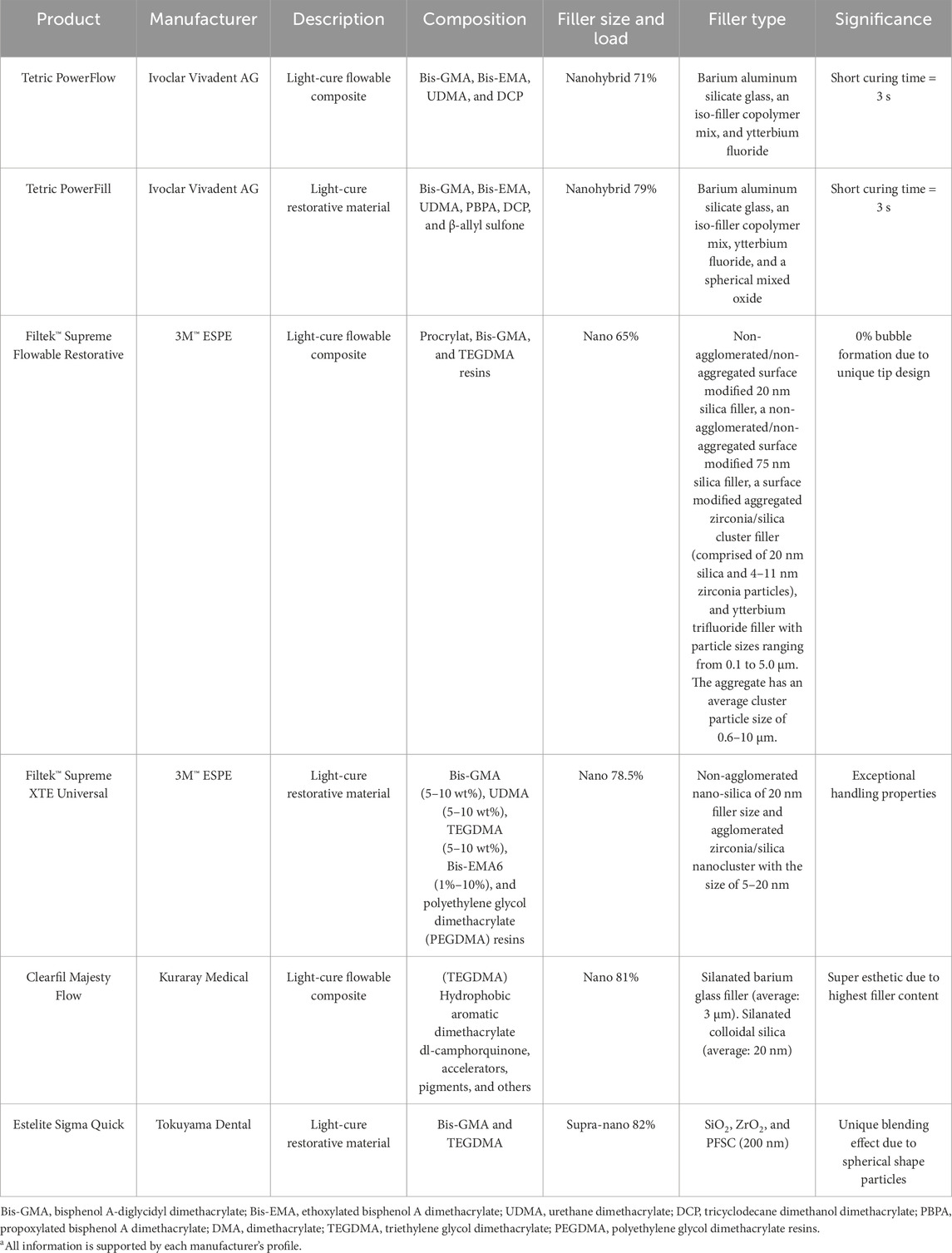- 1Department of Pediatric Dentistry and Orthodontics, College of Dentistry, King Saud University, Riyadh, Saudi Arabia
- 2Department of Preventive Dentistry, College of Dentistry, University of Ha’il, Ha’il, Saudi Arabia
Objectives: Due to a lack of thorough published research, orthodontists’ clinical preferences influence the choice of composite resin for clear aligner attachments. According to a recent study on bonded attachments, all evaluated composite resins showed notable volumetric loss during brushing and heat cycling; however, brand-specific variations were observed. Nevertheless, mass loss and surface roughness are not directly represented by roughness and weight measurements. Therefore, the aim of this research was to compare the surface roughness and mass loss of six types of composite resins.
Materials and methods: Ninety rectangular composite resin attachments (2 × 4 × 1 mm) were fabricated using three flowable composite resins (Tetric PowerFlow, Filtek™ Supreme Flowable Restorative, and Clearfil Majesty Flow) and three restorative composite resins (Tetric PowerFill, Filtek™ Supreme XTE Universal, and Estelite Sigma Quick). Surface roughness and mass were recorded at baseline (T1) and after intervention (T2), which included thermocycling, simulated brushing, and abrasive testing. A 3D optical microscope profilometer and an analytical balance were used for measurement. Paired t-tests, one-way ANOVA, and Bonferroni post hoc tests were used for statistical analysis.
Results: Using paired t-tests, all tested composite resins showed a statistically significant increase in surface roughness and mass loss (p < 0.05), except for Tetric PowerFill, which showed no significant surface change (p = 0.238). This was reflected by a homogenous parallel line as an abrasive effect, without obvious irregularities. Post hoc comparisons of final roughness at T2 between groups revealed that Filtek™ Supreme XTE Universal exhibited the highest surface roughness and the greatest mass loss (2.4% of total weight).
Conclusion: Tetric PowerFill demonstrated superior resistance to surface wear and mass degradation, making it the most suitable material among those tested for long-term use as clear aligner attachments. In contrast, Filtek™ Supreme XTE Universal was the least resistant, indicating a higher need for clinical monitoring and potential replacement.
1 Introduction
In 1999, clear aligner trays were introduced to the market as an invisible alternative to fixed orthodontic brackets. Significant progress has been made in the development of clear aligners, including the placement of composite to enhance the aligner’s retention and ensure more precise and reliable tooth movements (Morton et al., 2017; Kircelli et al., 2023).
Clear aligners have undergone significant advancements across consecutive generations. The first generation relied merely on the aligner material to produce orthodontic movement, making it suitable only for minor orthodontic tooth movements (Hennessy and Al-Awadhi, 2016). The second generation introduced attachments and intermaxillary elastics to enhance its effects; however, only minimal improvement in tooth movement was observed (Kravitz et al., 2009). The third generation marked a shift toward automation, with manufacturer software incorporating features such as precision cuts, elastics, power ridges, and optimized attachments, allowing for further clinical modification (Hennessy and Al-Awadhi, 2016). Fourth-generation aligners introduced G4 attachments, improved designs for multi-plane movements, and enhanced extrusion and root control, particularly in open bite cases (Bichu et al., 2023; Hartshorne and Wertheimer, 2022). The fifth-generation aligners integrated SmartTrack™ material for improved force delivery and patient comfort, along with precision bite ramps and beveled attachments for deep bite correction (Tamburrino et al., 2020; Kravitz et al., 2009). Sixth-generation aligners featured SmartStage™ technology, enhancing vertical control and anchorage in extraction cases (Bichu et al., 2023). The seventh generation (Invisalign G7) focused on better root control and open bite correction in adolescents, while the eighth generation, released in 2020, improved posterior expansion and minimized crown tipping using advanced ClinCheck software and SmartForce™ technology (Bichu et al., 2023). Despite these advancements, camouflage therapy is frequently the only option available for addressing skeletal class II and class III malocclusions with clear aligners.
Worldwide, many restorative composite resin products have been introduced to the market by different companies, each with its own strength properties. For example, high or low viscosity can be controlled by increasing or decreasing the amount of diluent monomer, such as triethylene glycol dimethacrylate (TEGDMA) (Asmussen, 1975). In addition, the percentage of filler loading and size of filler particles vary between the restorative composite resins to fulfill specific indications of use (O’Brien, 2002; Lutz and Phillips, 1983). One of the most important factors to be evaluated when choosing the type of composite resin for clear aligner attachments is the surface wear of the composite resin. In 1972, researchers defined wear as a progressive loss of substance from the surface of a body as a result of mechanical action (Jones et al., 1972). In the oral cavity, it can be caused by mastication force, tooth brushing, and repeated insertion and removal of clear aligner trays (Lindquist and Emilson, 1990). It is crucial to evaluate the chosen composite resin, which will be used as the clear aligner attachment since this phenomenon influences orthodontic force delivery with time, especially in complex movements or long treatment cases (Weckmann et al., 2020).
Various resin-based composite attachments have been studied for their efficacy with clear aligners (Mantovani et al., 2019; D’Antò et al., 2019; Chen et al., 2021). The surface roughness of aligner attachments is consideration in clinical practice since it can significantly affect surface stress and structural integrity by changing the dynamics of the interaction between the aligner material and attachment (Suter et al., 2020). Erbas and Atik (2025) conducted a recent study in which they assessed the surface roughness and attachment accuracy of four composite resins under two different curing light intensities. While surface roughness results varied based on the type of composite and curing procedure, their findings showed that the 3M ESPE FiltekTM Z350 XT Flowable Resin produced the maximum attachment accuracy. Despite these findings, there remains a scarcity of comprehensive research focusing on the surface roughness characteristics of composite resins specifically used for aligner attachments.
Due to a lack of thorough published research, orthodontists’ clinical preferences influence the choice of composite resin for clear aligner attachments. The precise behavior of various attachment composite resins under aligner-simulated settings has not yet been thoroughly described despite these observations. According to a recent study on bonded attachments, all evaluated composite resins showed a notable volumetric loss during brushing and heat cycling; however, brand-specific variations were observed (Ocak et al., 2025). Nevertheless, mass loss and surface roughness are not directly represented by roughness and weight measurements. Therefore, the aim of this research was to compare the surface roughness and mass loss of six types of composite resins. Three of them were low-viscous flowable composite resins such as Tetric PowerFlow (Ivoclar Vivadent AG), Filtek™ Supreme Flowable Restorative (3M™ ESPE), and Clearfil Majesty Flow (Kuraray Medical, Tokyo, Japan). In addition, the other three were high-viscous restorative composite resins such as Tetric PowerFill (Ivoclar, Vivadent AG), Filtek™ Supreme XTE Universal (3M™ ESPE), and Estelite Sigma Quick (Tokuyama Dental, Japan).
2 Materials and methods
2.1 Ethical approval
The research project was registered with the CDRC of KSU # PR0146, and the study was conducted at the Physical Laboratory, King Saud University, Riyadh, Saudi Arabia.
2.2 Sample size calculation
The sample size was calculated using G*Power software set at 85% statistical power. The calculation revealed that a sample size of 12 attachments per group was required to detect statistically significant differences in surface roughness and mass loss at an alpha level of 0.05.
2.3 Sample preparation
A customized split stainless-steel mold with dimension of 25 mm × 25 mm × 1 mm was manufactured. It has four slots, and each slot with dimensions of 4 mm × 2 mm × 1 mm was used to form the composite resin attachments (Figure 1). The dimensions of the composite resin attachments were 2 mm in width, 4 mm in length, and 1 mm in thickness. All composites’ resin attachments were made following the manufacturer’s instructions for Tetric PowerFlow (Ivoclar Vivadent AG), Filtek™ Supreme Flowable Restorative (3M™ ESPE), Clearfil Majesty Flow (Kuraray Medical, Tokyo, Japan), Tetric PowerFill (Ivoclar, Vivadent AG), Filtek™ Supreme XTE Universal (3M™ ESPE), and Estelite Sigma Quick (Tokuyama Dental, Japan) (Table 1). Before curing, the attachments were covered with a polyester matrix strip (TDV Dental Ltda., Santa Catarina, Brazil) and were slightly pressed using a glass slide to form a smooth, compact surface. Finally, any excess was removed carefully, and then the samples were numbered with a permanent marker from 1 to 12.
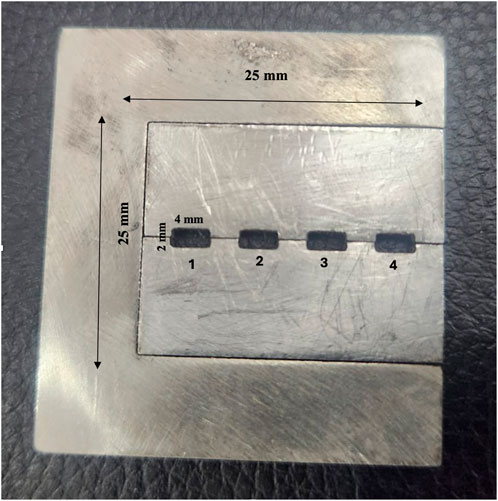
Figure 1. Customized split stainless-steel mold with dimensions of 25 mm × 25 mm × 1 mm having four slots (each slot with dimension of 4 mm × 2 mm × 1 mm) was used to form the composite resin attachment tested samples.
2.4 Intervention
Each composite resin attachment’s surface was scanned at T1 using a 3D optical microscope profilometer (ContourGT Profiler, Bruker, United States). Optical profilometer measurement is performed using a broadband light source that can detect surface irregularities (Sang et al., 2021). It provided a detailed 3D visualization, making it a highly effective and reliable tool for measuring surface roughness compared to other methods. An area of 2.279 × 1.709 mm2 at the center of each sample was determined using the XY-linear translation stage (Marzhauser Wetzlar, Germany) (Figure 2). In addition, attachments were weighted using a digital analytical balance (Radwag Scale XA 60/220, Poland), with an accuracy of 0.00001 g, recorded as T1 (before intervention) (Figure 3). To start the test, each group needed four molds, where each mold contained three rectangular attachments to be loaded to the tooth-brushing simulator machine ZM-3.8 (Figure 4).
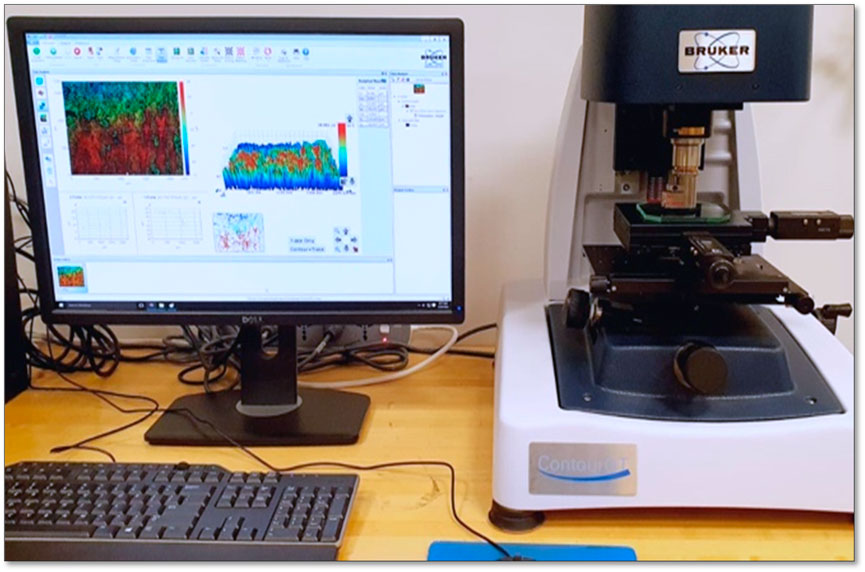
Figure 2. 3D optical microscope profilometer (ContourGT Profiler, Bruker, United States) for composite resin surface roughness scanning at T1 and T2.
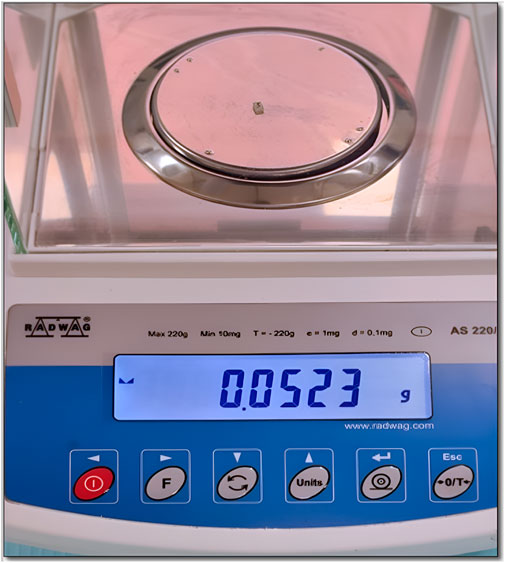
Figure 3. Digital analytical balance scale (Radwag Scale XA 60/220, Poland) for composite resin mass weight at T1 and T2.
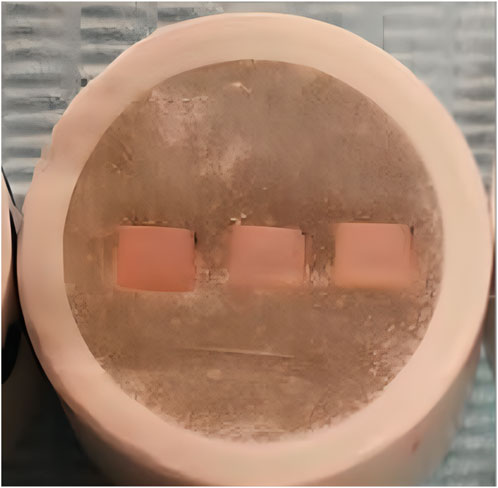
Figure 4. Composite resin rectangular attachments secured in a mold to be loaded in the tooth-brushing simulator machine ZM-3.8 (SD Mechatronik GMBH, Germany).
First, the intervention started with the aging process, in which each sample underwent thermocycling aging following ISO/TS 11405:2015 guidelines, using SD Mechatronic TC 45 (Huber, Germany), in two distilled water baths for 30 s each. The first bath had a temperature of 5°C, and the second had a temperature of 55°C. A 10-s transfer time was considered for 10,000 cycles, equal to 1 year of aging (ISO/TS 11405:2015 Dentistry—Testing of adhesion to tooth structure). Second, the samples were placed in a tooth-brushing simulator following ISO TS No. 14569-2 guidelines using a tooth-brushing simulator machine ZM-3.8 (SD Mechatronik GmbH, Germany). A soft toothbrush (Colgate Twister toothbrush, Vietnam) and a mixture of water and toothpaste (Colgate Advanced Whitening toothpaste, United Kingdom) were used, and the machine was set to circular brushing movement for 24 h, equal to 1 year of wear (Figure 5) (Monteiro and Spohr, 2015). Next, the discs were cleaned for 10 min using distilled water in an ultrasonic bath (Driclave, Columbus Dental, United States) before the next step. Finally, abrasive wear was intentionally induced on the composite resin surface samples. Therefore, following the International Organization for Standardization (ISO) recommendation about the technical specification of two-body wear, the abrasive intervention by the tooth-brushing simulator was used (Ilie et al., 2017). It offers the advantages of simulating sliding movement without applying force and allows for computer-controlled movement. The antagonist brush that slides on the top of the composite resin sample surface was customized to be covered by 0.76-mm multilayered thermoplastic polyurethane–polyethylene terephthalate glycol–thermoplastic polyurethane (TPU–PETG–TPU) clear aligner material (Figure 6a). The machine was set on linear motion, was 12 mm in diameter, and had a speed of 30 mm/s. The movement was continued for 24 h and 68,500 cycles, equal to 1 year of use (Figure 6b). Mounted samples after the intervention process are shown in Figure 7.
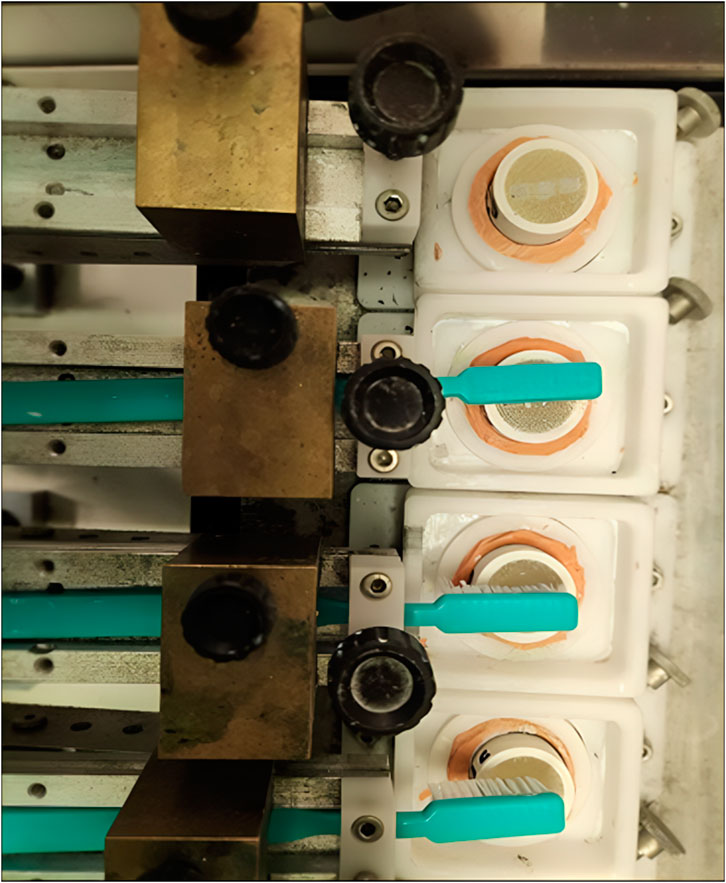
Figure 5. Second intervention: tooth brushing using a soft toothbrush (Colgate Twister toothbrush, Vietnam) and a mixture of water and toothpaste (Colgate Advanced Whitening toothpaste, United Kingdom) using tooth-brushing the simulator machine ZM-3.8 (SD Mechatronik GMBH, Germany) following ISO TS No. 14569-2 guidelines.
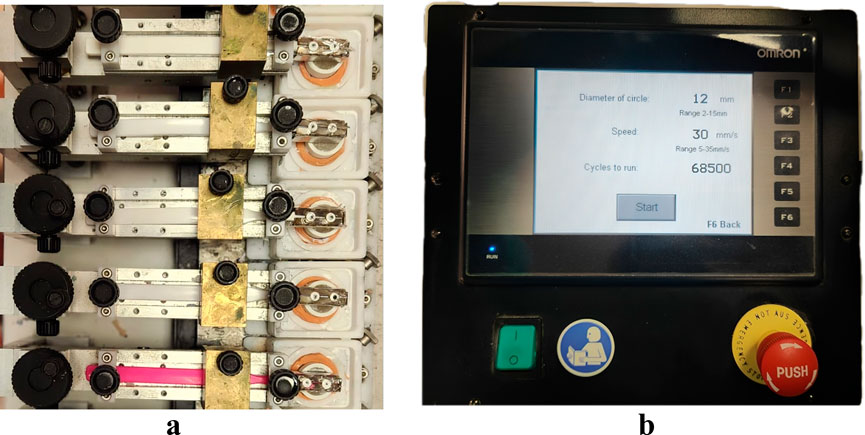
Figure 6. Last intervention: (a) surface abrasion formation by customized toothbrush loaded in tooth brushing simulator. (b) The machine was set on linear motion, with 12 mm diameter and a speed of 30 mm/s. The movement was continued for 24 h and 68,500 cycles.
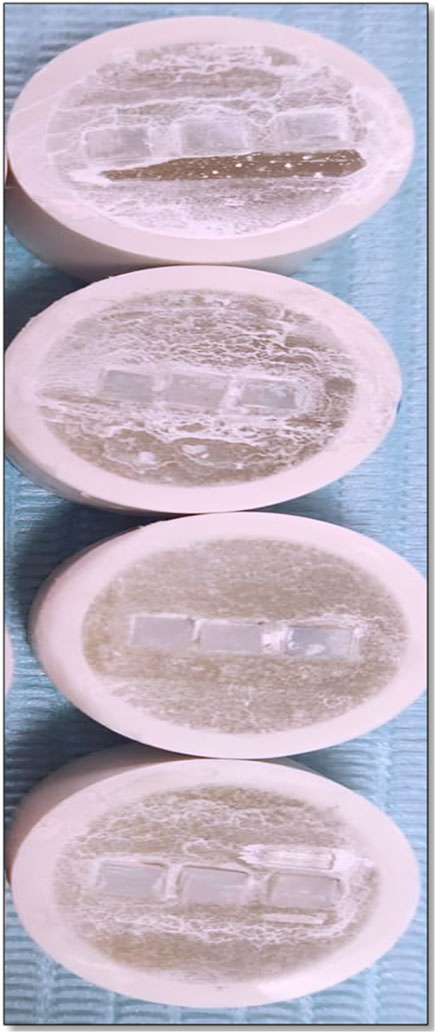
Figure 7. Example of composite resin rectangular attachments of the mounted sample post intervention.
2.5 Data collection
a. Surface roughness: T2 readings were collected using a 3D optical microscope profilometer (Contour GT Profiler, Bruker, United States), and the variable was expressed in µm as a roughness (Ra) value. This value represents the average value that expresses the mean distance between the peaks and valleys of the surface profile.
b. Mass loss: attachments were weighed again after intervention as T2 using a digital analytical balance (Radwag Scale XA 60/220, Poland). For each reading, an average of three readings was considered.
2.6 Statistical analysis
SPSS version 23 (SPSS Inc., IBM, Chicago, Illinois, United States) was used to gather and analyze the data using descriptive statistics such as mean and standard deviation. The normality of the data was evaluated using the Kolmogorov–Smirnov test, which showed normal data distribution. A paired t-test was used to compare the surface roughness and mass loss between pre- and post-intervention readings for each group. Subsequently, a one-way ANOVA test with a p-value of < 0.05 (which indicates significance) was used to verify the presence of differences in the variables between the six experimental groups. To account for the increased risk of type I error due to multiple comparisons, the significance level was adjusted using the Bonferroni correction.
3 Results
3.1 Surface roughness
3D optical microscope profilometer data were analyzed using a paired t-test for surface roughness, which showed an overall increase in the materials’ surface roughness from T1 (initial reading) to T2 (final reading) within each composite resin group (Table 2). A statistically significant change was detected in all groups of composite resins, except for the Tetric PowerFill group, which showed p = 0.238 and reflected a homogenous parallel line as an abrasive effect without obvious irregularities (Figure 8). On the other hand, a highly significant difference (p < 0.01) was observed in the Tetric PowerFlow composite resin group, which presented an irregular surface with varying elevations and depressions (Figure 9).
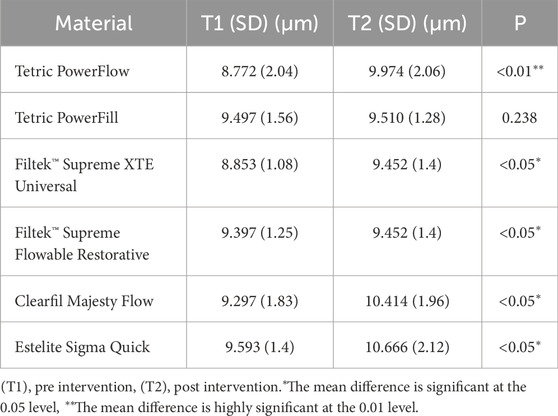
Table 2. Means and standard deviation (SD) of initial (T1) and final (T2) roughness (µm) after thermocycling, simulated tooth brushing, and abrasive testing within each group.
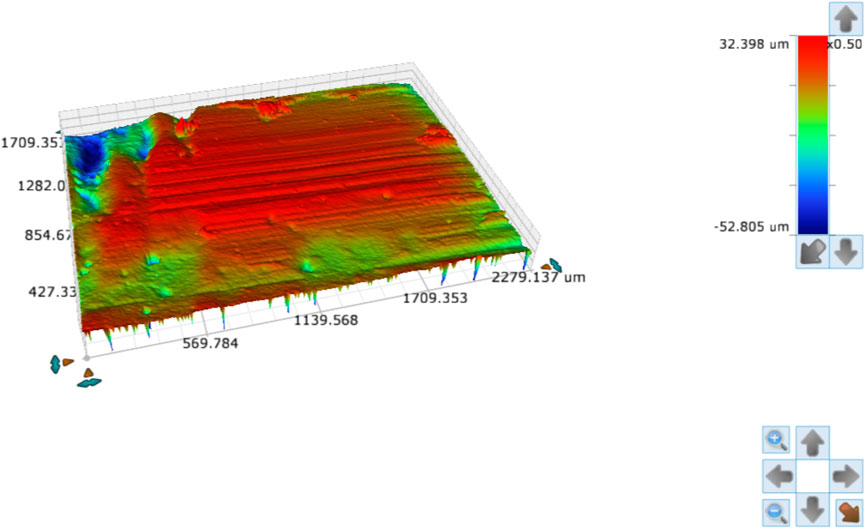
Figure 8. Tetric PowerFill composite resin 3D optical microscope picture of T2 surface roughness in µm as (Ra) value.
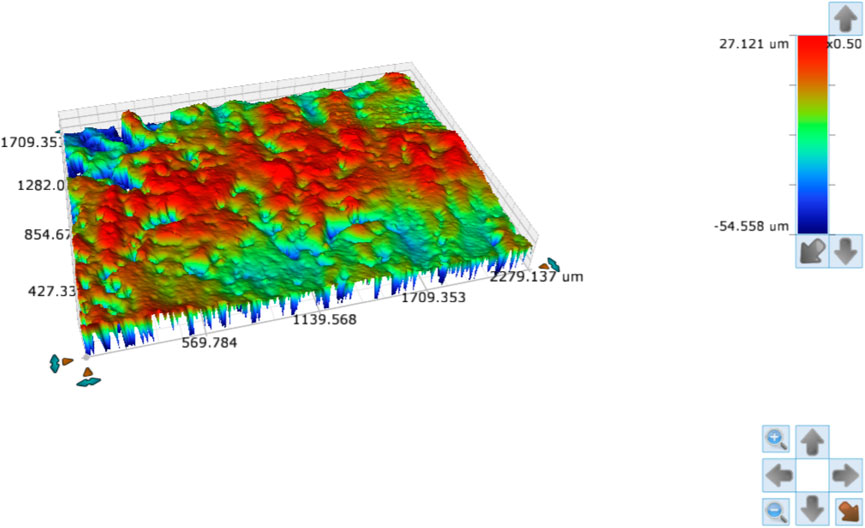
Figure 9. Tetric PowerFlow composite resin 3D optical microscope picture of T2 surface roughness in µm as (Ra) value.
In addition, post hoc analysis was used to compare the final roughness (T2) between the tested composite resin material groups, and only Filtek™ Supreme XTE Universal composite resin exhibited statistically greater roughness than all other resin composites (p < 0.05) (Table 3). The profilometer images showed great variation within the samples, displaying a combination of smooth parts along with hills and valleys of varying heights and depths (Figure 10).
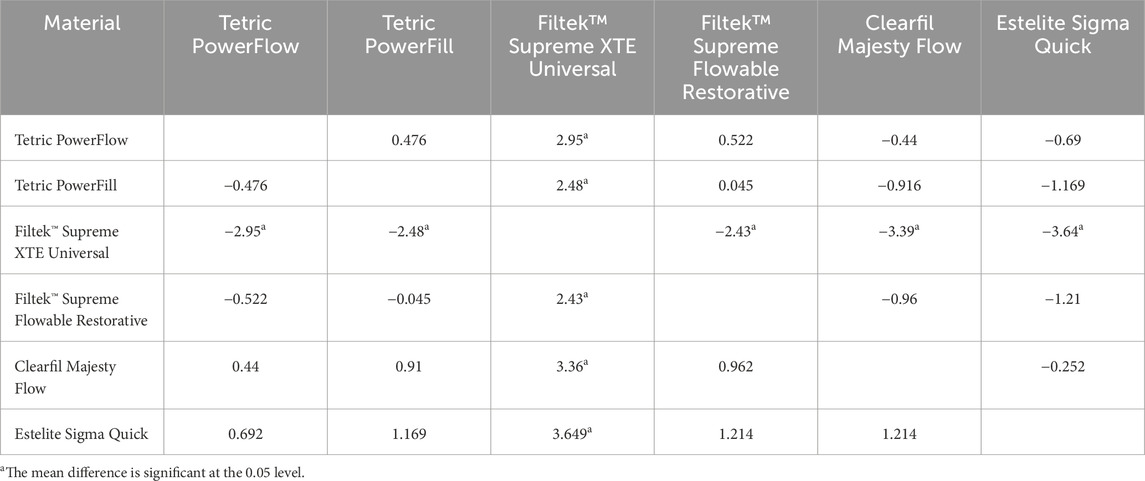
Table 3. Post hoc dependent variable; profilometer roughness (µm) between all type of composite resins.
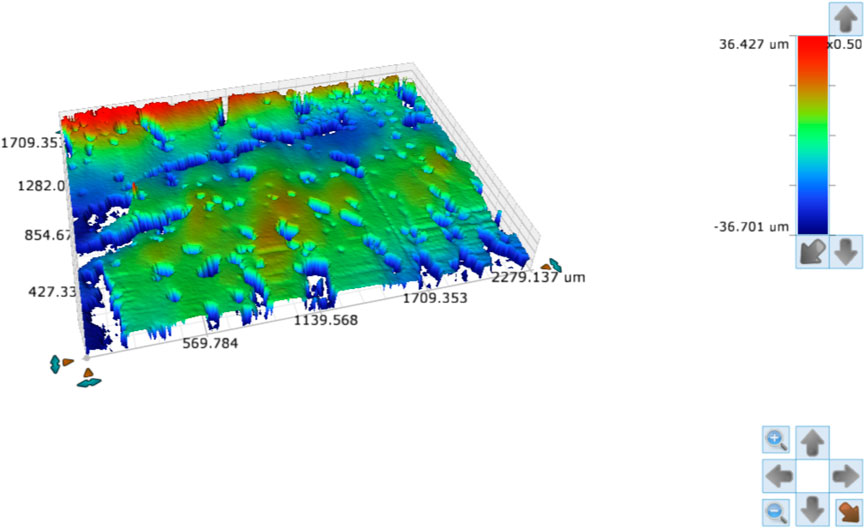
Figure 10. Filtek™ Supreme XTE Universal composite 3D optical microscope picture of T2 surface roughness in µm as (Ra) value.
3.2 Mass loss
Paired t-tests for each experimental group showed a highly significant difference (p < 0.01) in mass loss after the intervention in all composite resin groups. Filtek™ Supreme XTE Universal demonstrated the highest amount of mass loss, which accounted for 2.4% of the total weight. On the other hand, the minimum mass loss was found in Tetric PowerFill and Clearfil Majesty Flow, which was 1.19% of the total weight (Table 4).

Table 4. Means in grams of initial (T1) and final (T2) difference of mass loss (mg) and percentage loss (%) after thermocycling, simulated tooth brushing, and abrasive testing within each group.
4 Discussion
Dental composite resins are polymer-based materials composed of two main components, namely, organic elements (resin matrix, the coupling agent, and the initiator) and inorganic particles (Moszner and Salz, 2001). Organic resin matrix is usually based on methacrylate as 2,2-bis-[4-(2-hydroxy-3-methacryloyloxypropyl) phenyl] propane (bis-GMA), ethoxylated bis-GMA (EBPDMA), 1,6-bis-[2 methacryloyloyethoxycarbonyl-amino]-2,4,4-trimethylhexane (UDMA), dodecanediol dimethacrylate (D3MA), or TEGDMA (Peutzfeldt, 1991). It plays a major role in keeping the material flowable at room temperature and then transforms it to a solid polymer upon curing (Wright, 2018). The second part is inorganic fillers such as glass, quartz, colloidal silica, or zirconia, which reinforce the material’s strength, provide radiopacity, and enhance the handling properties. The filler size, shape, type, and loading percentage have an impact on the mechanical, optical, thermal, and polymerization shrinkage properties (Ferracane and Palin, 2012). One study found that it is difficult to describe the exact filler content differences between commercial materials (Randolph et al., 2016). In addition, it is challenging to accurately evaluate the effect of different resin compositions based on the filler size, type, or shape on specific physical or mechanical properties (García-Contreras et al., 2015).
In our research, we used six different types of composite resins, classified based on filler size and loading percentage, to evaluate their wear behavior through surface roughness measurements and mass loss. The experiment intervention started with an aging process involving thermocycling between low (5°) and high (55°) water bath temperatures simultaneously, which is equal to 1 year of aging. This aging process simulates the harsh intraoral environment, which can be as simple as oral enzymatic degradation and water sorption to as hard as mastication and parafunctional habits (Jaramillo-Cartagena et al., 2021; Nasoohi et al., 2017). Generally, thermocycling as an aging process causes coupling agents’ hydrolysis that affects the mechanical properties of the material, such as increasing the surface roughness (Delaviz et al., 2014). In addition, composite resins are used as clear aligner attachments to deliver orthodontic forces and retain the aligners. These attachments undergo repeated friction during placing and removing of the aligners, which causes surface roughness with time. As a result, plaque retention, composite resin discoloration, and subsequent failure of the restoration will take place (Pietrokovski et al., 2022). Because of that, the surface quality of the composite resin is one of the most important factors to be evaluated for esthetic and mechanical success.
In this in vitro study, overall increased roughness was found in all composite resin groups compared before and after the intervention, except in the Tetric PowerFill group, where its surface was affected the least. The Tetric line was introduced to the market by the company Ivoclar (Vivadent, Liechtenstein) (ISO 4049:2019). Researchers found a unique network homogeneity by integrating an addition–fragmentation chain transfer (AFCT) reagent in the organic matrix to improve the physical properties of Tetric PowerFill composite resin by internal molecular reorganization during curing (Gorsche et al., 2014). In addition, among all six groups, Tetric PowerFill has the maximum percentage of nanohybrid filler particles (79%), like the conventional composite resin, which improves flexural strength, fracture toughness, and wear resistance, indicating superior mechanical stability (Turssi et al., 2005). Alsahafi et al. (2023) evaluated volumetric wear of different types of bulk-fill composite resins, where Tetric PowerFill was one of the groups, after simulating chewing force at a load of 5 kg. They found no statistically significant difference until 500,000 load cycles were reached, a threshold that was not attained in this study (Alsahafi et al., 2023). On the other hand, Filtek™ Supreme Flowable Restorative was proposed to score the worst, but its composition of spherical mixed oxide pearls improved its performance even with the least amount of filler loading (Lee et al., 2005). This conclusion is supported by Ipek and Bilge (2024), who compared the surface roughness of different flowable composite resins after immersion in liquids at different pH values. They found that composite resin with supra-nano spherical filler content recorded lower Ra values due to the homogeneity of their spherical structure (Ipek and Bilge, 2024). Moreover, among all the experimental groups, Filtek™ Supreme XTE Universal composite resin showed the highest surface roughness. This can be explained by the material composition of the filler, which is composed of nanocluster fillers (∼78.5%) that offer excellent esthetics and polish retention but may be more prone to surface degradation under repetitive mechanical stress. They are a combination of non-agglomerated/non-aggregated 20 nm silica filler, non-agglomerated/non-aggregated 4–11 nm zirconia filler, and aggregated zirconia/silica cluster filler (comprised of 20 nm silica and 4–11 nm zirconia particles) (by manufacturer). The nano-fillers are weakly bonded within the organic matrix and can be easily detached from the matrix when continuous abrasive force is applied, resulting in a rougher surface that appears under the microscope as different heights of hills and depths of pits (Costa et al., 2007). Moreover, the presence of the zirconia filler plays a role in increasing surface roughness due to its hardness. The abrasive force will tend to remove the organic matrix faster than the hard zirconia fillers, which causes the variation in depth and hills (Costa et al., 2007). In addition, as a result of continuous abrasive force simulating 1 year of placing and removing the clear aligner trays, some mass loss was expected. The statistical analysis showed a highly significant mass loss in all experimental groups. It was the maximum in the Filtek™ Supreme XTE Universal composite resin by 2.4% of the total weight. Such a finding was proven in a recent study when surface roughness was evaluated after using two different finishing and polishing systems on different types of composite resins (Vinagre et al., 2023).
The results of surface roughness testing research are impacted by many factors, such as the surface preparation, type of the counterpart’s material, test machines, load applied, aging process, and the experimental materials. Different experimental conditions and counterparts were used, but none of them included clear aligner material as abrasive counterparts in a wet environment, which makes it difficult to compare the presented results with previous studies. Further clinical studies are recommended for long-term in vivo research to evaluate the performance and longevity of different composite resin attachment materials in actual oral environments.
5 Limitation and recommendation
This study has several limitations. The study was conducted under controlled laboratory conditions, which may not fully replicate the oral environment. Variables such as saliva, pH fluctuations, mastication forces, and temperature changes were not included, potentially affecting the generalizability of the results to clinical settings. For example, cyclic forces from aligner insertion/removal or chemical effects of saliva were not explicitly simulated. The sample size used for each composite resin material was relatively small, which may affect the statistical power and limit the detection of smaller but clinically relevant differences. The study measured surface roughness and mass loss over a short simulation period. Long-term wear and degradation patterns were not assessed, which are crucial for understanding clinical performance over the course of aligner therapy. Further research, including clinical trials, would be needed to confirm these trends in vivo.
6 Clinical implications
The results of this study underscore the importance of selecting composite resin materials for clear aligner attachments based not only on their esthetic and handling properties but also on their mechanical resilience. Given the frequent insertion and removal of aligners and their associated abrasive forces, materials with superior wear resistance are crucial for maintaining attachment integrity, force delivery accuracy, and long-term treatment efficacy. Tetric PowerFill, due to its minimal surface roughness change and lower mass loss, may offer improved clinical longevity and reduced need for replacement or repair during orthodontic treatment. In contrast, materials such as Filtek™ Supreme XTE Universal may require more frequent monitoring and maintenance due to their higher degradation under simulated intraoral conditions.
7 Conclusion
Within the limitations of this in vitro study, Tetric PowerFill demonstrated the highest resistance to surface degradation, with p = 0.238. Conversely, Filtek™ Supreme XTE Universal exhibited the greatest increase in surface roughness and the highest volumetric mass loss (2.4% of the total weight) following simulated intraoral aging, brushing, and abrasive conditions. Further clinical studies are recommended to validate these findings in vivo.
Data availability statement
The raw data supporting the conclusions of this article will be made available by the authors, without undue reservation.
Author contributions
RRA: Funding acquisition, Resources, Project administration, Formal analysis, Visualization, Validation, Writing – original draft, Data curation, Investigation, Conceptualization, Methodology, and Software. NA: Funding acquisition, Writing – review and editing. AA: Funding acquisition, Supervision, Writing – review and editing.
Funding
The author(s) declare that no financial support was received for the research and/or publication of this article.
Acknowledgments
The authors would like to thank Ibrahim Almuhidab, Eng. Mustafa Saleh, and Abd El-Aty Edrees, Industrial Engineering department, KSU, for their contribution in surface roughness analysis.
Conflict of interest
The authors declare that the research was conducted in the absence of any commercial or financial relationships that could be construed as a potential conflict of interest.
Generative AI statement
The authors declare that no Generative AI was used in the creation of this manuscript.
Publisher’s note
All claims expressed in this article are solely those of the authors and do not necessarily represent those of their affiliated organizations, or those of the publisher, the editors and the reviewers. Any product that may be evaluated in this article, or claim that may be made by its manufacturer, is not guaranteed or endorsed by the publisher.
References
Alsahafi, T. A., Walter, R., Nunes, M., and Sulaiman, T. A. (2023). Wear of bulk-fill composite resins after thermo-mechanical loading. Oper. Dent. 48, 416–424. doi:10.2341/22-039-L
Asmussen, E. (1975). Composite restorative resins: Composition versus wall-to-wall polymerization contraction. Acta Odontol. Scand. 33, 337–344. doi:10.3109/00016357509004638
Bichu, Y. M., Alwafi, A., Liu, X., Andrews, J., Ludwig, B., Bichu, A. Y., et al. (2023). Advances in orthodontic clear aligner materials. Bioact. Mater. 22, 384–403. doi:10.1016/J.BIOACTMAT.2022.10.006
Chen, W., Qian, L., Qian, Y., Zhang, Z., and Wen, X. (2021). Comparative study of three composite materials in bonding attachments for clear aligners. Orthod. Craniofacial Res. 24 (4), 520–527. doi:10.1111/ocr.12465
Costa, J., Ferracane, J., Paravina, R., Mazur, R. F., and Roeder, L. (2007). The effect of different polishing systems on surface roughness and gloss of various resin composites. J. Esthetic Restor. Dent. 19, 214–224. doi:10.1111/j.1708-8240.2007.00104.x
D’Antò, V., Muraglie, S., Castellano, B., Candida, E., Sfondrini, M. F., Scribante, A., et al. (2019). Influence of dental composite viscosity in attachment reproduction: an experimental in vitro study. Materials 12 (23), 4001. doi:10.3390/ma12234001
Delaviz, Y., Finer, Y., and Santerre, J. P. (2014). Biodegradation of resin composites and adhesives by oral bacteria and saliva: a rationale for new material designs that consider the clinical environment and treatment challenges. Dent. Mater. 30, 16–32. doi:10.1016/j.dental.2013.08.201
Erbas, S., and Atik, E. (2025). A comparative in vitro study of different composite materials in terms of aligner attachment accuracy and surface roughness using different curing irradiances. Int. Orthod. 23 (2), 100961. doi:10.1016/j.ortho.2024.100961
Ferracane, J., and Palin, W. (2012). “Effects of particulate filler systems on the properties and performance of dental polymer composites,” in Non-metallic biomaterials for tooth repair and replacement, 294–335. doi:10.1533/9780857096432.3.294
García-Contreras, R., Scougall-Vilchis, R., Acosta-Torres, L., Arenas-Arrocena, C., García-Garduño, R., and de la Fuente-Hernández, J. (2015). Vickers microhardness comparison of 4 composite resins with different types of filler. J. Oral of Res. 4, 313–320. doi:10.17126/joralres.2015.061
Gorsche, C., Griesser, M., Gescheidt, G., Moszner, N., and Liska, R. (2014). β-allyl sulfones as addition-fragmentation chain transfer reagents: a tool for adjusting thermal and mechanical properties of dimethacrylate networks. Macromolecules 47, 7327–7336. doi:10.1021/ma501550b
Hennessy, J., and Al-Awadhi, E. A. (2016). Clear aligners generations and orthodontic tooth movement. J. Orthod. 43, 68–76. doi:10.1179/1465313315Y.0000000004
Ilie, N., Hilton, T. J., Heintze, S. D., Hickel, R., Watts, D. C., Silikas, N., et al. (2017). Academy of dental materials guidance—resin composites: Part I—mechanical properties. Dent. Mater. 33, 880–894. doi:10.1016/J.DENTAL.2017.04.013
Ipek, I., and Bilge, K. (2024). The effect of different liquids on the surface roughness and color stability of single shade and nanohybrid resin composites: an AFM and SEM analysis. Microsc. Res. Tech. 87, 2063–2071. doi:10.1002/jemt.24586
Jaramillo-Cartagena, R., López-Galeano, E. J., Latorre-Correa, F., and Agudelo-Suárez, A. A. (2021). Effect of polishing systems on the surface roughness of nano-hybrid and nano-filling composite resins: a systematic review. Dent. J. (Basel). doi:10.3390/dj9080095
Jones, D. W., Jones, P. A., and Wilson, H. J. (1972). A simple abrasion test for composites. J. Dent. 1, 28–34. doi:10.1016/0300-5712(72)90039-5
Kircelli, B. H., Kilinc, D. D., Karaman, A., Sadry, S., Gonul, E. Y., and Gögen, H. (2023). Comparison of the bond strength of five different composites used in the production of clear aligner attachments. J. Stomatology, Oral Maxillofac. Surg. 124 (6), 101481. doi:10.1016/j.jormas.2023.101481
Kravitz, N. D., Kusnoto, B., BeGole, E., Obrez, A., and Agran, B. (2009). How well does Invisalign work? A prospective clinical study evaluating the efficacy of tooth movement with Invisalign. Am. J. Orthod. Dentofac. Orthop. 135, 27–35. doi:10.1016/j.ajodo.2007.05.018
Lee, Y. K., Lu, H., Oguri, M., and Powers, J. M. (2005). Changes in gloss after simulated generalized wear of composite resins. J. Prosthet. Dent. 94, 370–376. doi:10.1016/j.prosdent.2005.08.006
Lindquist, B., and Emilson, C. (1990). Distribution and prevalence of mutans streptococci in the human dentition. J. Dent. Res. 69, 1160–1166. doi:10.1177/00220345900690050801
Lutz, F., and Phillips, R. W. (1983). A classification and evaluation of composite resin systems. J. Prosthet. Dent. 50, 480–488. doi:10.1016/0022-3913(83)90566-8
Mantovani, E., Castroflorio, E., Rossini, G., Garino, F., Cugliari, G., Deregibus, A., et al. (2019). Scanning electron microscopy analysis of aligner fitting on anchorage attachments. J. Orofac. Orthop. 80 (2), 79–87. doi:10.1007/s00056-018-00167-1
Monteiro, B., and Spohr, A. M. (2015). Surface roughness of composite resins after simulated toothbrushing with different dentifrices. J. Int. Oral Health 7, 1–5.
Morton, J., Derakhshan, M., Kaza, S., and Li, C. (2017). Design of the Invisalign system performance. Seminars Orthod. 23 (1), 3–11. doi:10.1053/j.sodo.2016.10.001
Moszner, N., and Salz, U. (2001). New developments of polymeric dental composites. Prog. Polym. Sci. 26 (4), 535–576. doi:10.1016/s0079-6700(01)00005-3
Nasoohi, N., Hoorizad, M., Farnaz, S., and Tabatabaei, S. F. (2017). Effects of wet and dry finishing and polishing on surface roughness and microhardness of composite resins. J. Dent. 14, 69–75.
O’Brien, W. J. (2002). Dental materials and their selection. 3rd Edition. Chicago: Quintessence Publishing Co. Inc.
Ocak, I., Gorucu-Coskuner, H., and Aksu, M. (2025). Wear resistance of orthodontic attachments: a comparative analysis of different composite resins in clear aligner therapy. Clin. Oral Investig. 29, 242–247. doi:10.1007/s00784-025-06316-2
Peutzfeldt, A. (1991). Resin composites in dentistry: the monomer systems. Ear J. Oral Sci. 105, 97–116. doi:10.1111/j.1600-0722.1997.tb00188.x
Pietrokovski, Y., Zeituni, D., Schwartz, A., and Beyth, N. (2022). Comparison of different finishing and polishing systems on surface roughness and bacterial adhesion of resin composite. Materials 15, 7415. doi:10.3390/ma15217415
Randolph, L. D., Palin, W. M., Leloup, G., and Leprince, J. G. (2016). Filler characteristics of modern dental resin composites and their influence on physico-mechanical properties. Dent. Mater. 32, 1586–1599. doi:10.1016/J.DENTAL.2016.09.034
Sang, E. J., Song, J. S., Chung, S. H., Jin, B. H., and Hyun, H. K. (2021). Influence of a new polishing system on changes in gloss and surface roughness of resin composites after polishing and brushing. Dent. Mater. J. 40, 727–735. doi:10.4012/DMJ.2020-207
Suter, F., Zinelis, S., Patcas, R., Schätzle, M., Eliades, G., and Eliades, T. (2020). Roughness and wettability of aligner materials. J. Orthod. 47 (3), 223–231. doi:10.1177/1465312520936702
Tamburrino, F., D’antò, V., Bucci, R., Alessandri-Bonetti, G., Barone, S., and Razionale, A. V. (2020). Mechanical properties of thermoplastic polymers for aligner manufacturing: in vitro study. Dent. J. (Basel). doi:10.3390/dj8020047
Turssi, C. P., Ferracane, J. L., and Vogel, K. (2005). Filler features and their effects on wear and degree of conversion of particulate dental resin composites. Biomaterials 26, 4932–4937. doi:10.1016/j.biomaterials.2005.01.026
Vinagre, A., Barros, C., Gonçalves, J., Messias, A., Oliveira, F., and Ramos, J. (2023). Surface roughness evaluation of resin composites after finishing and polishing using 3D-profilometry. Int. J. Dent. 2023, 1–12. doi:10.1155/2023/4078788
Weckmann, J., Scharf, S., Graf, I., Schwarze, J., Keilig, L., Bourauel, C., et al. (2020). Influence of attachment bonding protocol on precision of the attachment in aligner treatments. J. Orofac. Orthop. 81, 30–40. doi:10.1007/s00056-019-00204-7
Keywords: surface properties, profilometer, analytical balance, rectangular attachments, abrasive
Citation: Alshammari RR, Alshihah N and Aldweesh A (2025) Quantitative evaluation of surface roughness and mass loss for different types of composite resins used for clear aligner attachments: an in vitro study. Front. Mater. 12:1614811. doi: 10.3389/fmats.2025.1614811
Received: 22 April 2025; Accepted: 15 May 2025;
Published: 18 June 2025.
Edited by:
Vinod Ayyappan, King Mongkut’s University of Technology North Bangkok, ThailandReviewed by:
Yashas Gowda T. G., Malnad College of Engineering, IndiaLin Feng Ng, University of Technology Malaysia, Malaysia
Balaji N. S., National Institute of Technology, Andhra Pradesh, India
Copyright © 2025 Alshammari, Alshihah and Aldweesh. This is an open-access article distributed under the terms of the Creative Commons Attribution License (CC BY). The use, distribution or reproduction in other forums is permitted, provided the original author(s) and the copyright owner(s) are credited and that the original publication in this journal is cited, in accordance with accepted academic practice. No use, distribution or reproduction is permitted which does not comply with these terms.
*Correspondence: Rana R. Alshammari, NDQxMjA0NjU3QHN0dWRlbnQua3N1LmVkdS5zYQ==
 Rana R. Alshammari
Rana R. Alshammari Nada Alshihah1
Nada Alshihah1